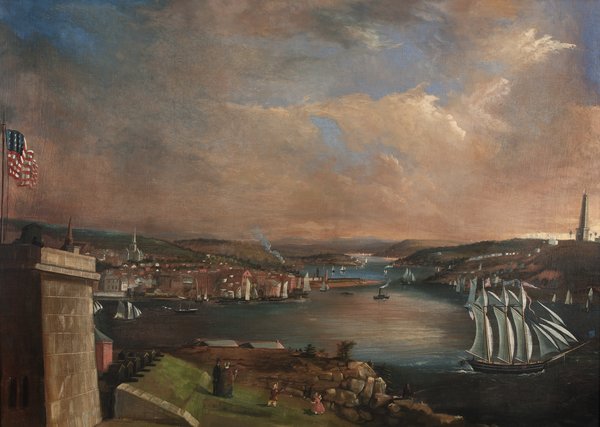Eileen Donovan
Director of Learning & Engagement
Lyman Allyn Art Museum
TEACHER'S SNAPSHOT
Subjects:
Architecture, Art, Maritime History
Course Topics/Big Ideas:
Innovation, Industry, and Economic Growth
Town:
Groton, New London
Grade:
Grade 3
Lesson Plan Notes
The painting View of New London from Fort Trumbull (1850-59) serves as a primary source document for its presentation of significant landmarks and industry in New London during the mid-nineteenth century. New London is historically significant land for the Pequot Tribe, the site of battles during the Revolutionary War, the location of the Coast Guard Academy, and was one of the largest whaling ports in the world during the nineteenth century.
The painting depicts New London’s growing prominence by highlighting various structures that were built during the mid-nineteenth century. These important visible landmarks include Fort Trumbull (1852, left foreground), the New London Custom House (1835, white building on the left), St. James Episcopal Church (1850, red church), The First Congregational Church (1850, white church), and Fort Griswold and the Groton Monument (1830, far right). Additionally, it shows numerous sailing and steam ships, illustrating the thriving and technologically evolving maritime industry at the time.
ESSENTIAL QUESTION
SUPPORTING QUESTIONS
- What types of events change a place?
- What events occurred in our local community and how did they shape our community?
- How do landmarks help shape the story of a place?
- What can we learn from looking closely at a historic image?
ACTIVITY
Have the students study and discuss the painting together.
- What do they see?
- Make a list of everything students notice. If they make a leap from observation to analysis/assumption, ask, “What do you see that makes you say that?”
- What clues do the students notice that can tell us when this painting was made?
- What different types of building and structures do they see? (residential, commercial, religious, military, commemorative, etc.)
- What else is in the painting that shows something important to this area?
- Why do they think the artist chose to show the area from this perspective?
Briefly discuss the background history of New London (see above) and the major buildings represented in the picture. Use an online search engine to find pictures of what New London looks like today. Compare those images with the painting.
- What buildings or other features have stayed the same in the city?
- What is different about the city?
Discuss how paintings can be used as primary sources.
- How can a work of art made in a particular time and place (painting, photographs, etc.) act as a historical record? What other sources can we use to determine how historically accurate a work of art is?
- In what ways is the information presented in a landscape painting similar to, or different from, that in a map?
OPPORTUNITIES FOR ASSESSMENT
- Discuss and make a list of landmarks or historical structures in your town or local area. Which ones are new? Which ones have been there a while? Do you know the history behind any of the older landmarks?
- Have the students make a landscape work of art (can be a painting, drawing, or even a photograph), that presents some of these landmarks. Share and discuss their works of art. Which landmarks did the students include? How did the students make different decisions about what to include and what to leave out?
RESOURCE TOOL KIT

Frederick L. Allen, View of New London from Fort Trumbull, 1850-1859, oil on canvas. Lyman Allyn Art Museum.
ADDITIONAL RESOURCES
Places to GO
Lyman Allyn Art Museum, New London
Fort Trumbull State Park, New London
Fort Griswold, Groton
Custom House Maritime Museum, New London
Things To DO
Read: Exploring Landscape Art With Children, by Gladys S. Blizzard, Charlbridge Publishing, 1996. 9780934738958.
Read: Cityscape: Where Science and Art Meet, by April Pulley Sayre, Greenwillow Books, 2020. 978-0062893314.
Websites to VISIT
Articles to READ
American Perspectives Gallery Guide, Lyman Allyn Art Museum
ConnecticutHistory.org: “The Rise and Fall of Sealing in Early New London Industry”



